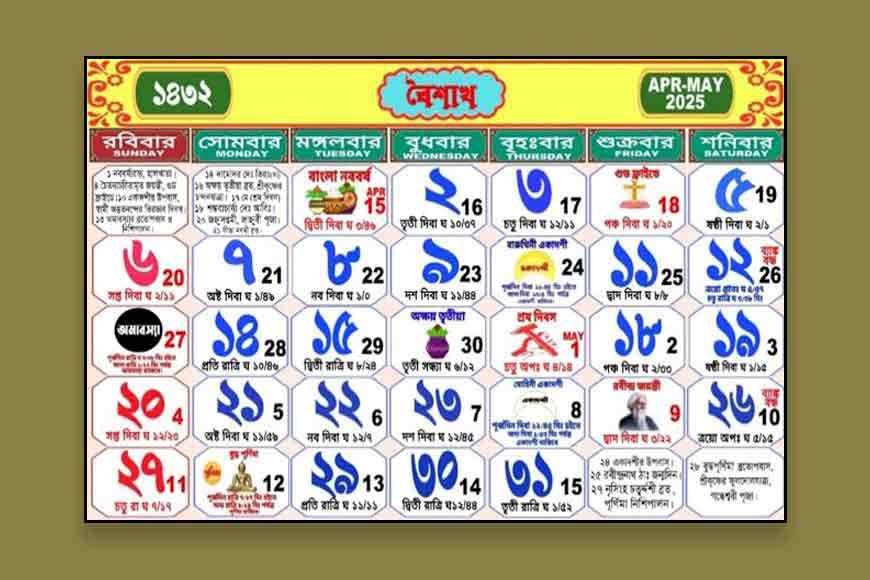From Ritual to Revival: The Calendar That Won’t Fade - GetBengal Story

In the life of Bengalis, the charm of the Bangla Calendar during Poila Boishakh (Bengali New Year) has faded. Our own calendar is no longer part of daily life. Except for a few traditional events like weddings, sacred rituals, or some small businesses, most people don’t feel the need for Bengali dates anymore.
Just a decade ago, devoted Bengalis needed a calendar that felt truly their own. In every Bengali household, the Bangla calendar was once essential. The Western calendar introduced by Pope Gregory didn’t quite fit.
Back in the 15th century, during the rule of Alauddin Husain Shah, Bengal saw the beginning of its own calendar system. It was a blend—Islamic lunar calculations and the Hindu solar system, put together by scholars. So, the calendar tracked both the moon’s phases and the sun’s journey.
In those days, on the walls of mud houses, the head of the family would draw the calendar by hand on the first day of the year. A red sun drawn with sindoor marked a full, bright sun; a black one with kajal ink showed a sun hidden by Rahu (eclipse). That’s how the Bengali folk calendar grew—adding words like ek chandra (one moon), duye paksha (two fortnights), chhoye ritu (six seasons), and noye nabagraha (nine planets).
In a way, using shadows and sunlight, the Bengali people created their own unique calendar—drawn, counted, and deeply felt.
During the reign of Emperor Akbar, Bengal once again received a calendar of royal importance—this time with a different purpose. Akbar wanted to create a calendar that would help fix dates for collecting taxes from the fertile lands of Bengal. This new calendar was called the Tarikh-e-Ilahi. It was a unique blend, using names and terms from both Sanskrit and Islamic traditions—for months, dates, the moon, and the sun.
Also read : A few Bengali calendar basics as we begin 1429
The calendar was designed by Fathullah Shirazi, Akbar’s royal astronomer, and it became a refined version of the Bengali calendar, meant to serve both administrative needs and the cultural essence of Bengal.
As time passed, a new era arrived, and the Bangla calendar went through many changes. Yet, some core elements remained the same. For instance, the calendar still keeps the six distinct seasons, with two months assigned to each one. Each month was also named after a specific star or nakshatra. For example, Boishakh comes from Vishakha, Joishtho from Jyeshtha, Asharh from Uttara-Ashadha, and Shrabon from Shravana, and so on. Similarly, from the nine celestial bodies or navagraha, seven were chosen to name the seven days of the week.
The seasons and months were all carefully linked to agriculture, to follow the rhythm of sowing and harvesting. There was even a clever way of writing the year number. Take, for example, the year 1425 in the old style. It would be written as “Panchaban Paksha Ved Chandra Batsar.” This was read in reverse: Chandra meant 1, Ved meant 4, Paksha meant 2, and Panchaban meant 5. Put together, that gives you 1425. This symbolic system was followed for many years—a beautiful mix of science, language, and tradition.
During the Swadeshi era, a new tradition began—adding the names and birthdays of national leaders and great thinkers to the calendar. In printing presses, calendars started featuring the names and portraits of Rabindranath Tagore, Netaji Subhas Chandra Bose, Kazi Nazrul Islam, Sri Ramakrishna, and Swami Vivekananda. Alongside calculations of eclipses, Rahu, and Ketu, Bengalis included respectful tributes to their national heroes.
Calendars with such dates were published directly by panjika (almanack) offices. They also included dates for the many festivals and rituals that fill the Bengali year, famously known as “baro mase tero parbon” (thirteen festivals in twelve months).
With time, colourful images were added, and eventually, shopkeepers began printing their own calendars, often with their store’s name on it, especially around Hal Khata time (Bengali New Year bookkeeping day). That tradition continues even today.
For quite some time, the demand for calendars had hit rock bottom. According to a report published in a leading newspaper, the calendar business across the state suffered major losses over the past two years.
But this year, the picture had changed significantly before Poila Boishakh. Traders experienced a surge in calendar orders, with many struggling to keep up with the rising demand for both paper and calendars. To cope with the market pressure, prices were even increased.
This situation clearly shows that interest in Bengali calendars is making a comeback, both in villages and cities, reviving the tradition around Poila Boishakh.










